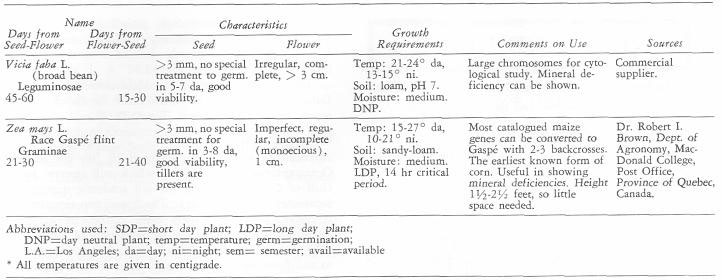Plant Science Bulletin archiveIssue: 1967 v13 No 2 Summer
|
|
Scientific Name |
Common Name |
Family Name |
|
Amaranthus retroflexus L. |
redroot |
Amaranthaceae |
|
Anemone caroliniana Walt. |
anemone |
Ranunculaceae |
|
Bidens spp. |
bur-marigold |
Compositae |
|
Brassica nigra (L.) Koch |
black mustard |
Cruciferae |
|
Chorispora tennella (Willd) D.C. |
|
Cruciferae |
|
Collins/a parviflora Dougl. |
blue-eyed Mary |
Scrophulariaceae |
|
Crocidium multicaule Hook |
|
Compositae |
|
Datura stramonium L. |
jimson weed |
Solanaceae |
|
Delphinium spp. |
larkspur |
Ranunculaceae |
|
Festuca octoflora |
fescue-grass |
Gramineae |
|
Floerkea proserpinacoides Walld. |
false mermaid |
Limnanthaceae |
|
Galinsoga parviflora Cay. |
raceweed |
Composite |
|
Gymnoster/s nut/lc-au/is |
|
Polemoniaceae |
|
Holosteum umbellatum L. |
jagged chickweed |
Caryophyllaceae |
|
Houstonia minima Beck. |
star violet |
Rubiaceae |
|
Hypericum spp. |
St. John's wort |
Gurtiferae |
|
Lepidium sativum L. |
garden cress |
Cruciferae |
|
Lesquerella spp. |
|
Cruciferae |
|
Lithephragma bulbif era Rydb. |
star-flower |
Saxifragaceae |
|
Oxalis stricta L. |
wood sorrel |
Oxalidaceae |
|
Phacelia parryae |
|
Hydrophyllaceae |
|
Polygonum aviculare L. |
knotweed |
Polygonaceae |
|
Portulaca oleracea L. |
purslane |
Porrulacaceae |
|
Sanguinaria canadensis L. |
bloodroot |
Papaveraceae |
|
Sedum spp. |
stone crop |
Crassulaceae |
|
Solarium nigrum L. |
night shade |
Solanaceae |
|
Taraxacum off icinale Weber |
dandelion |
Compositae |
|
Townsendia exscapa (Richards) Porter |
|
Compositae |
|
Veronica pars ice Poir. |
birds-eye |
Scrophulariaceae |
|
Xanthium pennsylvanicum Wallr. |
cocklebur |
Compositae |
|
|
|
|
Sources of Weed Seeds
-
Seed Stocks of Virginia, Inc., Box 217, Sandston, Virginia.
-
Mr. Roy A. Swanson, Thorp, Wisconsin.
-
Dr. S. M. Raleigh, Professor, Department of Agronomy, Pennsylvania State University, University Park, Pennsylvania.
-
Valley Seed Service, 2007 Alameda Avenue, Davis, California 95616.
-
Mr. Allenby L. White, Northrup King & Company, P.O. Box 521, Berkeley 1, California.
-
Mr. Norman G. Elsbury, R.R. 1, Fortville, Indiana.
-
Consult Seed Trade Buyers Guide. Compiled and issued by Seed World Publications, 327 South LaSalle Street, Chicago 4, Illinois. Request list of commercial seed companies who are usually able to supply weed seeds as a result of their clean-up operations.
* * * * * * * *
Corrigenda. Two corrections noted in the proof for Dr. Solberg's article in the last issue were somehow missed. The final two sentences of the paragraph that began page two should have been as follows:
Also, not all cytoplasm of any given cell is "vesiculate." Simple observations such as these should provide researchers with hints as to how to approach the study of living cells, as corroborated by electron microscopy.
In the last line of item (g) on page 3 there should have been an arrow connecting the words "code" and "protein."
|
Plant Science Bulletin |
|
Adolph Hecht, Editor |
|
Department of Botany, Washington State University |
|
Pullman, Washington 99163 |
|
Editorial Board |
|
Harlan P. Banks, Cornell University |
|
Norman H. Boke, University of Oklahoma |
|
Sydney S. Greenfield, Rutgers University |
|
William L. Stern, Smithsonian Institution |
|
Erich Steiner, University of Michigan |
|
June, 1967 Volume Thirteen Number Two |
|
Changes of Address: Notify the Treasurer of the Botanical Society |
|
of America, Inc., Dr. Harlan P. Banks, Department of Botany, |
|
Cornell University, Ithaca, New York 14850. |
|
Subscriptions for libraries and persons not members of the Bo- |
|
tanical Society of America are obtainable at the rate of $4.00 a |
|
year. Send orders with checks payable to "Botanical Society of |
|
America, Inc." to the Treasurer. |
|
Material submitted for publication should be typewritten, double- |
|
spaced, and sent in duplicate to the Editor. Copy should follow |
|
the style of recent issues of the Bulletin. |
6
NEWS AND NOTES
Sourcebook of Methods in Developmental Botany
The Developmental Section and the Committee on Education of the Botanical Society of America are sponsoring the preparation of a Sourcebook of Methods in Develop-mental Botany for use by teachers of botany and biology. The Sourcebook is designed to assist the teacher in introducing developmental botany into the curriculum by providing detailed information on developmental experiments and exercises which can be done by students with limited time, equipment, and training.
The Sourcebook will have a standard format giving details of materials needed (and sources of supply), lead time for preparation and estimated time for student manipulations and the collection of data. Techniques will be presented and illustrated where appropriate, and there will be suitable references and indication of the relation of the experiment to general biological concepts.
The Sourcebook Committee solicits the ideas and techniques of teachers and research workers in plant growth and development—broadly interpreted. We would appreciate techniques and experiments which personal experience has shown to work and to be stimulating to students. Please contact any member of the Committee:
Richard M. Klein (Chairman), The New York Botanical Garden, Bronx, N.Y. 10458.
John H. Miller, Biological Research Laboratories, Syracuse University, Syracuse, N.Y. 13201.
Walter G. Rosen, Department of Biology, State University of New York, Buffalo, N.Y. 14214.
Russell B. Stevens, Department of Botany, George Washington University, Washington D.C. 20006.
Sanford S. Tepfer, Department of Biology, University of Oregon, Eugene, Ore. 97403.
The 1968 Hoblitzelle National Award in the Agricultural Sciences
Members of the Botanical Society of America may submit nominations for candidates for the 1968 Hoblitzelle Award to the Chairman of the Botanical Society Nomination Committee, K. F. Baker, Department of Plant Pathology, University of California, Berkeley, California 94720, by September 1, 1967.
This will be the eighth Hoblitzelle Award presented since its creation in 1950. The Award, which consists of $10,000 in cash, a gold medal, and a certificate, was established to encourage and recognize notable contributions of potential importance in American agriculture. It is given as recognition for the outstanding scientific publication (s) during the preceding four-year period. For the 1968 Award, the period is January 1, 1963 to December 31, 1966.
All Americans working in the United States or its Territories are eligible. Either an individual or two members of a team of scientists who have contributed the basic ideas may be nominated. "The Award covers re-search in agronomy, animal husbandry, bacteriology, biochemistry, botany, entomology, genetics, horticulture, nutrition, soil science, veterinary medicine, zoology, and such other sciences as may be deemed to serve agriculture in their broadest aspects."
Donor of the Award is the Hoblitzelle Foundation of Dallas, Texas, and it is administered by the Texas Re-search Foundation, Renner, Texas 75079.
Oceanographic Awards
Applications will be accepted until 10 July for Stanford Oceanographic Expedition 16, which will operate in the Gulf of California during the fall academic quarter (18 September to 1 December). The Expedition represents an intensive, 15-unit graduate level course in Biological Oceanography given at sea by a faculty of three. Ten NSF Awards covering board and room, transportation to and from the research vessel, and tuition are available. Applicants may be of either sex, but must be research oriented with a Bachelor's degree in some field of biology. For information contact: Dr. Malvern Gilmartin, Hopkins Marine Station, Pacific Grove, California 93950.
Torrey Botanical Club Centennial
The Torrey Botanical Club is celebrating its 100th anniversary this year. Special programs are scheduled throughout the year, with the cooperation of all institutions in the area, under the general theme of a hundred years of botany in New York City and environs.
The program for 1967 is as follows:
January 17, Annual Dinner and Meeting—Dr. Wm. J. Crotty (New York University) "Ferns and Problems of Differentiation".
February 18, Open House: Boyce Thompson Institution for Plant Research, Dr. George L. McNew, Director. Symposium: "Cell Physiology as an Approach To Solving Plant Problems—Control of Growth Processes, Pathogenesis in Plants and Insects, Demonstration of Experimental Procedures Used in Cell Physiology Research, Air Pollution and Plant Growth, Microbial Physiology".
March 25, Dedication of the John Torrey Room, The New York Botanical Garden, Dr. William C. Steere, Director—"John Torrey (1796-1873), His Life and Times" —Christine Chapman Robbins and Dr. William J. Robbins.
April 15, Rockefeller University, Dr. Detlev W. Bronk, President. "Normal and Abnormal Growth"—Dr. Armin C. Braun, presiding. Participants: Drs. Reddi, W. J. Robbins, B. Voeller, H. Wood.
May 6, Open House: Brooklyn Botanic Garden, Dr. George S. Avery, Director. "Botanical Gardens Collections, Research and Educational Programs".
June 17, Symposium (Fordham University).
Participants: Dr. Wm. A. Niering (Connecticut College)
"Pesticides in Our Ecosystem"
Dr. Frank E. Egler ( Atop Forest)
"The Urban Ecosystem—The Natural Area in Re-search, Education and Cultural Recreation"
Dr. Tom T. Stonier (Manhattan College) "Socio-political Aspects of Ecological Problems as Viewed by a Biologist"
7
Dr. Robert H. Daines (Rutgers University)
"Air Pollutions and Plant Response, a Changing Problem"
Dr. John J. A. McLaughlin (Fordham University) Round Table Discussion: "Water Pollution, Conservation and Productivity".
Father Alan J. McCarthy, Ecologist, Fordham
Hon. Richard Ottinger, U.S. Representative, New York Professor Walter Smith, Ecologist, Suffolk College
Centennial Dinner (Fordham University)
Dr. Harold H. Clum (Hunter College, N.Y. Botanical Garden)
"History of the Torrey Botanical Club"
June 18-21, Summer Field Meeting (with Northeastern Section of Botanical Society of America) Sterling Forest (New York University), Tuxedo, New York. Drs. C. Heusser, M. F. Buell, L. J. Crockett, J. A. Small.
August 27-September 1, A. I. B. S. Meeting, College Station, Texas A. & M. University, Torrey Symposium, Sponsored by Botanical Society of America and the Torrey Botanical Club: "Some Subjects of Interest to John Torrey: the Family Cyperaceae, the Genus Eriogonum, and a North American Flora." Organized by Dr. Lorin I. Nevling (Harvard University), Dr. Arthur Cronquist (N.Y. Botanical Garden), and Dr. L. J. Crockett (College of the City of New York).
Participants: Dr. Joseph Ewan (Tulane University) "Only 10 Feet Less"
Dr. Alfred E. Schuyler (Acad. Natural Sciences, Philadelphia)
"Research Challenges in the Cyperaceae"
Dr. Tetsuo Koyama (N.Y. Botanical Garden) "Systematic Position and Classification of the Cyperaceae-Mapanioideae, with Special Reference to the Systematic Significance of Micromorphological Characters"
Dr. Galen Smith (Wisconsin State, Whitewater) "Natural Hybridization, Ecology and Species Boundaries in the Scirpus lacustris Complex in North America"
Dr. James L. Reveal (Smithsonian Institution) "The Subgeneric Concept in Eriogonum (Polygonaceae)"
Dr. Roy L. Taylor (Plant Research Institute, Ottawa) "North America Flora—Project '67"
Dr. Lawrence J. Crockett (C.C.N.Y.)
Summary and Comments
August 30, Torrey Social for Botanists (Ramada Inn) 3:30-5:00 p.m.
September 30, Open House: New York Botanical Garden Tour of Collections 2:00-5:00 p.m.
October 28, "Phytopharmacology of Botanic Drugs in Modern Medicine"
Brooklyn Center, Long Island University
Arranged by Ralph H. Cheney (L. I. U.) 10:00 a.m.-4:00 p.m.
Speakers: Dr. Nestor Bohonos (Lederle Laboratories) Topic to be announced
Dr. Norman R. Farnsworth (U. Pittsburgh) "Hallucinogenic Plants—What and Why"
Dr. George M. Hocking (Auburn University) "PIant Flavors and Aromatic Values in Medicine" Dr. Richard E. Schultes (Harvard University)
"The Unfolding Panorama of New World Narcotic Plants"
Dr. Gordon H. Svoboda (Eli Lilly Research Laboratories)
"The Current Status of Research on the Alkaloids of Catharanthus roseus G. Don (Vinca rosea Linn.) and Their Role in Cancer Chemotherapy"
Dr. Andrew T. Well (Harvard)
"Nutmeg and other Psycho-active Groceries" November 18, Cell Biology, Recent Advances in Cytology and Genetics
C. W. Post College of Long Island University. Brookville, N.Y.
Arranged by Dr. N. Meiselman (C. W. Post) December 26-31, "Morphogenesis '67," Sponsored by Section G., A.A.A.S.
(W. C. Steere) and the Torrey Botanical Club, meeting at Columbia University. Arranged by: W. J. Crotty (N.Y.U.), E. B. Matzke (Columbia), T. Stonier (Manhattan), and W. C. Steere (N.Y. Botanical Garden)
The above program, with some modification, will be edited and published as a Torrey Memorial Volume.
Book Reviews
Surange, K. R. Indian Fossil Pteridophytes. Botanical Monograph No. 4, viii + 209 pp., 2 tables, 101 figs. Council of Scientific and Industrial Research, New Delhi, 1966. $8.00.
This book, by the Director of the Birbal Sahni Institute of Palaeobotany at Lucknow, is a comprehensive account of the fossil spore-bearing vascular plants of India. The arrangement is according to plant groups, and within each group the geological sequence is followed. All known species are redescribed, and the location of the type specimens, places of origin, and geological horizons are given. Almost all species are illustrated, mostly by photographs but sometimes by line drawings. The printing is excellent on good paper. Photographs are clear, and errors, either factual or typographical, are few. It is the most complete regional work on paleobotany to appear recently, and it is hoped similar volumes on other plant groups will appear soon. Chester A. Arnold.
Bainbridge, R., G. C. Evans and O. Rackhan (eds.) . Light as an Ecological Factor. John Wiley & Sons, Inc., N.Y., 1967. 452 pp. $13.50.
This, the seventh in the series of annual symposia sponsored by the British Ecological Society, concerns not only light but other wavelengths of radiant energy as components of the environment of organisms. Despite insistance that all the contributions be actually delivered at the meeting, workers experienced on six continents participated. Eight of the papers deal with problems in measuring and characterizing the light climate in forests, open areas and under water. Five discuss aspects of light in the ecology of terrestrial plants, and three deal with marine
8
algae. Although animal ecology might be expected to get Iimited attention relative to plants in a consideration of light as an environmental factor, there is one paper each on insects, sea urchins, and periwinkles, and three concern the underwater vision of fishes. The contributions end with a brief and incomplete but still useful section on methods of study, supported by literature references. A comprehensive index to authors and subject matter is provided. R. Daubenmi're,
Cutter, Elizabeth G., Editor. Trends in Plant Morphogenesis. John Wiley and Sons, Inc., 1966. 329 pp. $11.25. This volume is at once a significant contribution to plant morphogenesis and a fitting tribute to an entire man. While the 17 essays constitute the largest portion of the book, the most impressive feature by far is the portrayal —in preface, foreword, and bibliography—of Professor Wardlaw himself as a man, soldier, artist, writer, and a triple-threat botanical scientist. The essays, presented to Wardlaw honouring his 65th birthday, were prepared by persons influenced by him as students or as colleagues.
The topics covered range widely over the field of morphogenesis but without pretending to textbook completeness. The intent was to describe the forefront of research in each area rather than to review exhaustively the literature of the subject. On the whole the objective has been met very successfully. The list of authors includes, among others, F. C. Steward, A. Allsopp, P. Maheshwari, G. L. Stebbins, J. Heslop-Harrison, Ian Sus-sex, P. Martens, R. H. Wetmore, Elizabeth G. Cutter, P. F. Wareing, D. J. Carr, and E. Bunning. Major headings include: Organization in Plant (5 articles), Embryology, Differentiation and Its Control (3 articles), Phylogeny and Morphogenesis (2 articles), Regulation of Growth and Form (5 articles). Morphogenetic problems of fungi, algae, bryophytes, ferns, and gymnosperms as well as angiosperms are discussed.
This book is rather precisely what the title suggests. It should prove very useful and is strongly recommended to all who are interested in principles and problems of development.
N. Higinbothamn.
Davis, Gwenda L. Systematic Embryology of the Angiosperms. John Wiley & Sons, Inc., 1966. 528 pp. $19.75. This volume is the logical successor to the 1931 German reference, "Vergleichende Embryologic der Angiospermen," by Karl Schnarf, and follows the general plan of its predecessor. A general section of 20 pages covers Systematic and Taxonomic Characters, Taxonomic Evaluation of Embryological Characters, and a somewhat cursory review of the anatomical features of the anther, ovule, and associated tissues. The general section is followed by 248 pages summarizing embryological characteristics of the plant families, considered in alphabetical order. The Hutchinson (1959) system is followed. The present volume lists some 5000 references compared with fewer than 2000 in the German book. Unlike its predecessor the book by Davis has no illustrations, but like the earlier volume ends with an index to genera and families.
Adolph Hecht. Personalia
Dr. L. Wallace Miller, a faculty member of Chico State College since 1957, will become Dean of the college's newly created School of Natural Sciences on September 1, 1967. A recognized authority on the Hydnaceae, Dr. Miller is currently vice-chairman of the Teaching Section of the Botanical Society. He has organized and will pre-side at the 1967 Teaching Section Symposium: Concepts in Botany—Advance College Courses.
Dr. William A. Weber, curator of the herbarium in the University of Colorado Museum, has received a Colorado Faculty Fellowship to do research next year in Canberra, Australia. In cooperation with Dr. Donald McVean of the Australian National University, Dr. Weber plans to collect specimens, particularly mosses and lichens, at high altitudes in Australia and New Guinea. Dr. and Mrs. Weber plan to arrive in Australia in September, 1967, and will remain in that vicinity for 12 months.
Dr. Harvey A. Miller of Miami University has accepted a new position as Chairman of the Program in General Biology and Professor of Botany at Washington State University, as of August 15, 1967. In addition to his involvement in the General Biology Program, Dr. Miller will continue his researches on the bryophytes, and later will offer a course in bryology.
Dr. Lewis K. Shumway has accepted a position as Assistant Professor of Genetics and Botany at Washington State University beginning August 15, 1967. Dr. Shumway is now completing a year of postdoctoral work under Professor R. B. Park at the University of California, Berkeley; a previous year of postdoctoral study was spent at the Davis campus under Professor T. E. Weier.
Dr. Ralph H. Cheney, retired as of September 1, 1966 as Professor Emeritus of Biology at Brooklyn College, is now Adviser to the Biology Department and Director of the Biology Graduate Seminars at the Brooklyn Center Campus of Long Island University, Brooklyn, New York 11201.
Dr. William L. Stern has accepted a position as Professor of Botany at the University of Maryland beginning July 1, 1967. Dr. Stern has been chairman of the Department of Botany at the Smithsonian Institution, and will continue an active relationship with the Smithsonian as an Honorary Research Associate. At Maryland he will be in charge of the beginning course in botany, and will develop a course or courses in comparative plant anatomy. He plans to continue his research in plant anatomy and to take an active part in graduate research instruction for this field of botany at the University of Maryland.
<left> 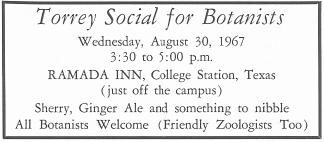
</left>
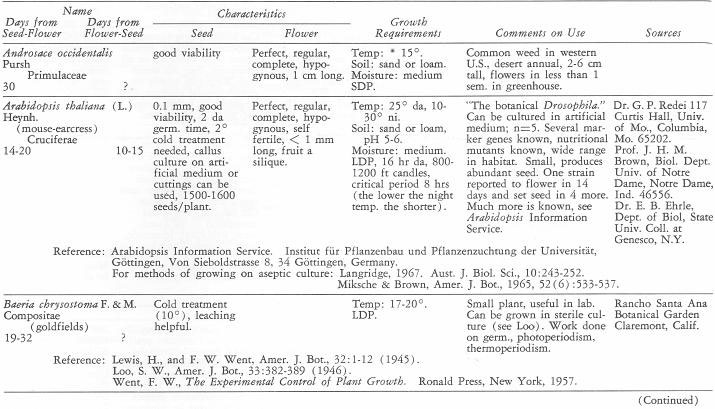 </left>
</left>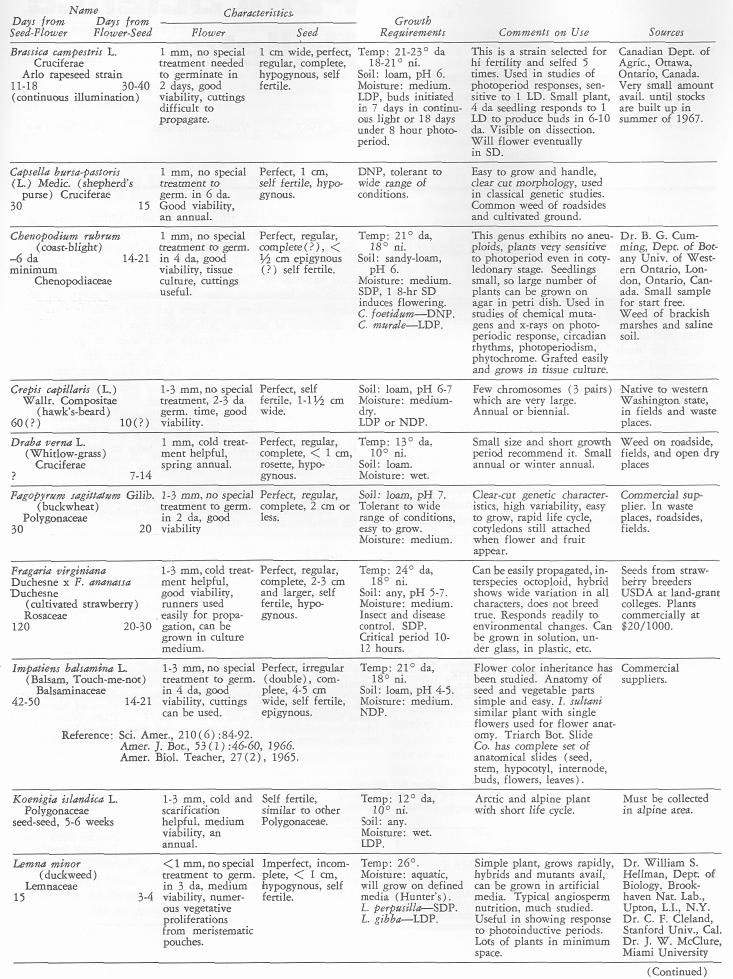 </left>
</left>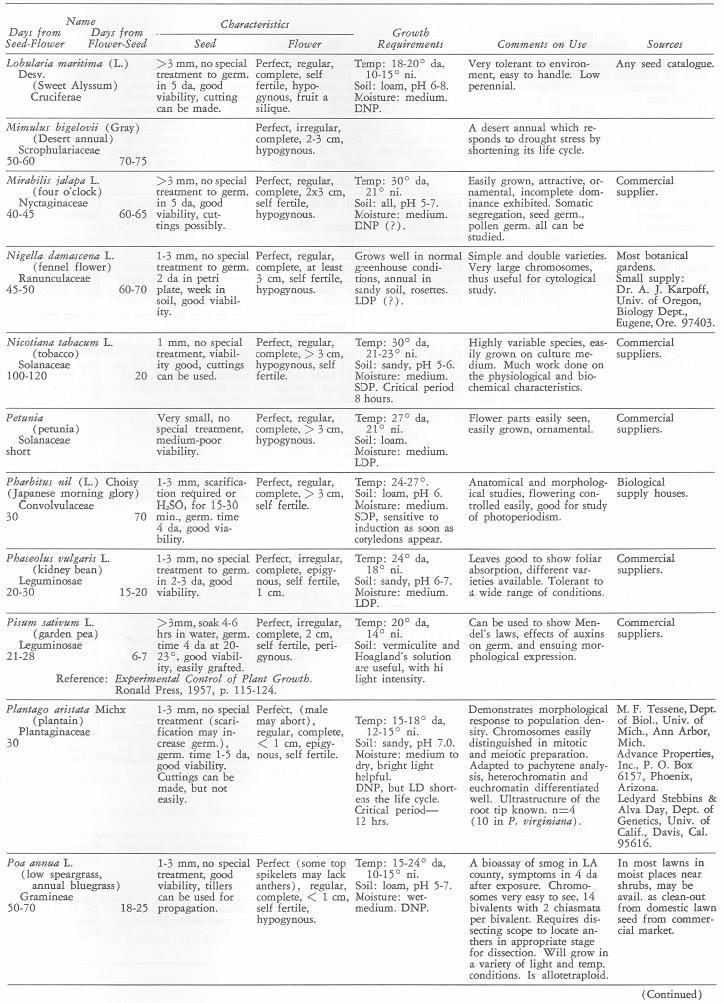 </left>
</left>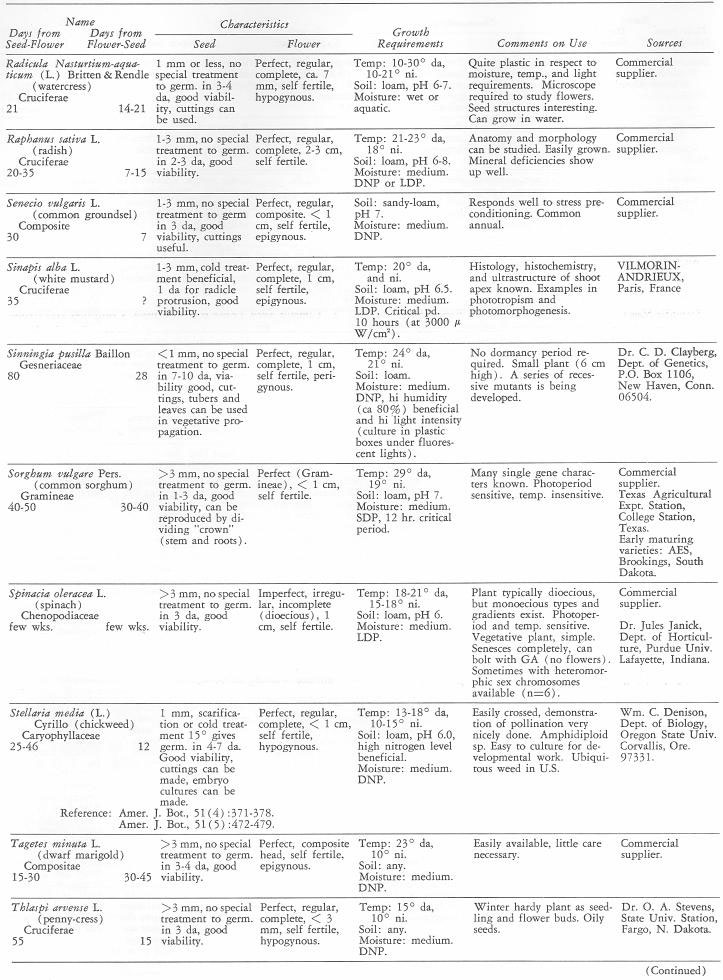 </left>
</left>